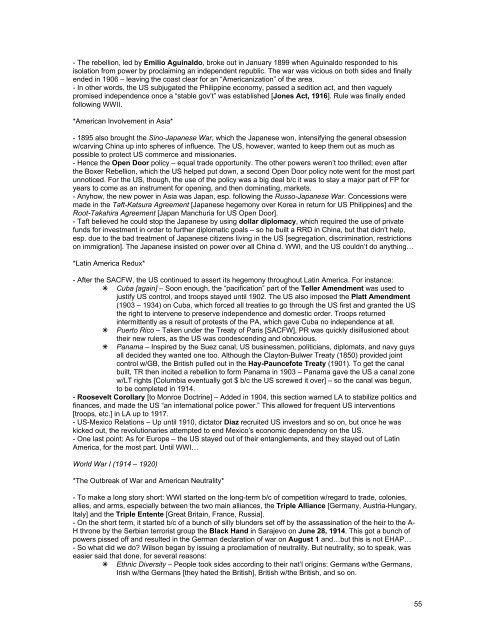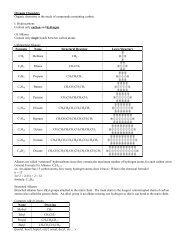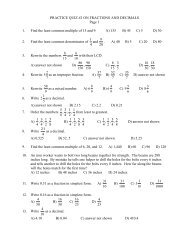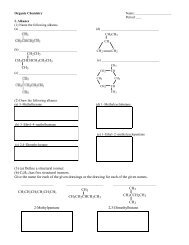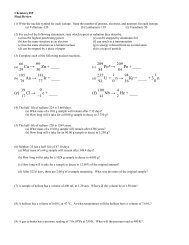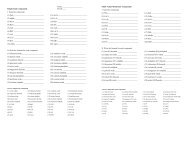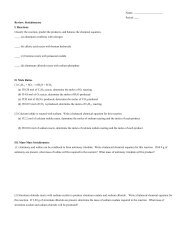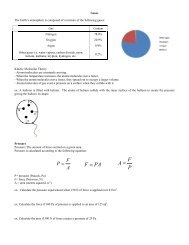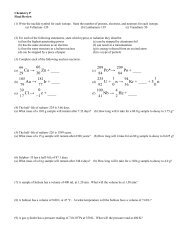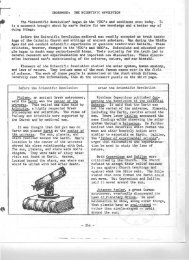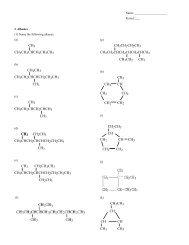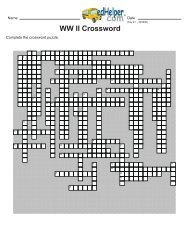Increasing Influence in Latin <strong>Am</strong>erica – We held Pan-<strong>Am</strong>erican conferences, let people tourour factories and sign trade treaties, founded the Pan-<strong>Am</strong>erican Union, and humiliatedcountries like Chile when our drunk sailors got into fights w/their citizens (1891).- Then there was the whole New Navy deal, as promoted by Capt. Alfred T. Mahan [The Influence of SeaPower upon <strong>His</strong>tory (1890)], which went along the lines of: let’s get a huge navy and lots of bases to protectour foreign trade.*Crises in the 1890s*- In the 1890s, expansionism expanded [very funny, right] due to the economic depression and the beliefthat the home frontier had closed. The main examples are… Hawaii – By the 1880s, Hawaii was already largely part of the US system due to the fact thatthe <strong>Am</strong>erican elite owned most of the country and subordinated the economy to the USthrough duty-free sugar exports. This control culminated in the 1887 constitution, which gaveforeigners the right to vote and shifted authority to the legislature. When the McKinley Tariffof 1890 got rid of the duty-free sugar provision, the elite pressed for annexation – but QueenLili’uokalani wanted to resist the power of the foreigners – so the elite formed the AnnexationClub and took over by force in 1893. When Cleveland found out about what had occurred, hetemporarily stopped the annexation process, but once Hawaii got attn. again during theSACFW [you’ll see] McKinley got it though as the Newlands Resolution [1898]. Hawaiianswere given citizenship in 1900 and statehood in 1959. Venezuela – In 1895 Venezuela asked for US help regarding a border dispute w/GB. We gavethe British a big lecture on leaving LA alone, and then in 1896 an Anglo-<strong>Am</strong>erican boarddivided the territory up w/o consulting Venezuela. Cuba – Cuba had battled Spain for independence intermittently since 1868, and in 1895another revolution led by Jose Marti broke out. As usual, the US had acquired strongeconomic interests in the region [one of the causes of the revolution was the Wilson-GormanTariff, which taxed their sugar, hurting the economy]. So when the revolution led to destructionof sugar fields and such, it killed trade, leading to US sympathy for Cuba (Spain’s brutalpolicies were another factor). Naturally the yellow journalists had a field day feeding war fever.The last straw was the accidental explosion of the US ship Maine, which journalists blamed onSpain, and a letter found by the NY Journal criticizing McKinley. McKinley then sent Spain anultimatum – Spain made concessions – but McKinley went ahead and asked to use forceanyway. So on April 19, 1897 Congress declared Cuba free and allowed the use of authorityto remove Spain. Though the Teller <strong>Am</strong>endment claimed we weren’t interested in annexation,McKinley still didn’t let us recognize the rebel gov’t [they might need US tutoring first].- That, of course, leads to the…*The Spanish-<strong>Am</strong>erican-Cuban-Filipino War [SACFW] and its Aftermath*- E/t Spain seemed somewhat ready to <strong>com</strong>promise, it pretty much wasn’t going to work out b/c the Cubansonly wanted full independence, which Spain wasn’t going to give them at all and the US didn’t want so mucheither b/c the new gov’t might try to reduce our interests there.- Just to quickly recap – why were we interested in war? There were the humanitarian concerns about theSpanish policies, business concerns about <strong>com</strong>merce and US interests, general imperialistic drives,idealistic social gospel type ideas about saving others, and sensationalism.- Anyhow, the Spanish fleet was quickly destroyed by Dewey in the Philippines, and Spain suffered furtherproblems due to the US blockade of the Cuban ports and the US attack on Puerto Rico. As a result, anarmistice was signed on August 12, 1898.- The peace terms were then worked out in Paris [where else] in December: an independent Cuba, cessionof the Philippines, PR & Guam to the US, and US payment in return. Imperialists rejoiced, of course, butthere still was a very significant opposition.- Anti-imperialists included Mark Twain, Bryan, Jane Addams, Carnegie, and many more – somementioned principles [like self-determination], others advocated the peaceful acquisition of markets, otherspointed out the potential costs of maintaining empires, others felt it would undermine <strong>Am</strong>erican racial purity,and union leaders worried the new immigrants could undercut <strong>Am</strong>erican labor.- But the Anti-Imperialist League [launched November 1898] was ultimately unsuccessful due to domesticpolicy divisions between the participants, and the fact that the US had already annexed the islands. Still,imperialists responded w/the usual patriotic and economic arguments. And once the Filipinos started toresist, of course, we couldn’t pull back at the risk of looking cowardly.54
- The rebellion, led by Emilio Aguinaldo, broke out in January 1899 when Aguinaldo responded to hisisolation from power by proclaiming an independent republic. The war was vicious on both sides and finallyended in 1906 – leaving the coast clear for an “<strong>Am</strong>ericanization” of the area.- In other words, the US subjugated the Philippine economy, passed a sedition act, and then vaguelypromised independence once a “stable gov’t” was established [Jones Act, 1916]. Rule was finally endedfollowing WWII.*<strong>Am</strong>erican Involvement in Asia*- 1895 also brought the Sino-Japanese War, which the Japanese won, intensifying the general obsessionw/carving China up into spheres of influence. The US, however, wanted to keep them out as much aspossible to protect US <strong>com</strong>merce and missionaries.- Hence the Open Door policy – equal trade opportunity. The other powers weren’t too thrilled; even afterthe Boxer Rebellion, which the US helped put down, a second Open Door policy note went for the most partunnoticed. For the US, though, the use of the policy was a big deal b/c it was to stay a major part of FP foryears to <strong>com</strong>e as an instrument for opening, and then dominating, markets.- Anyhow, the new power in Asia was Japan, esp. following the Russo-Japanese War. Concessions weremade in the Taft-Katsura Agreement [Japanese hegemony over Korea in return for US Philippines] and theRoot-Takahira Agreement [Japan Manchuria for US Open Door].- Taft believed he could stop the Japanese by using dollar diplomacy, which required the use of privatefunds for investment in order to further diplomatic goals – so he built a RRD in China, but that didn’t help,esp. due to the bad treatment of Japanese citizens living in the US [segregation, discrimination, restrictionson immigration]. The Japanese insisted on power over all China d. WWI, and the US couldn’t do anything…*Latin <strong>Am</strong>erica Redux*- After the SACFW, the US continued to assert its hegemony throughout Latin <strong>Am</strong>erica. For instance: Cuba [again] – Soon enough, the “pacification” part of the Teller <strong>Am</strong>endment was used tojustify US control, and troops stayed until 1902. The US also imposed the Platt <strong>Am</strong>endment(1903 – 1934) on Cuba, which forced all treaties to go through the US first and granted the USthe right to intervene to preserve independence and domestic order. Troops returnedintermittently as a result of protests of the PA, which gave Cuba no independence at all. Puerto Rico – Taken under the Treaty of Paris [SACFW], PR was quickly disillusioned abouttheir new rulers, as the US was condescending and obnoxious. Panama – Inspired by the Suez canal, US businessmen, politicians, diplomats, and navy guysall decided they wanted one too. Although the Clayton-Bulwer Treaty (1850) provided jointcontrol w/GB, the British pulled out in the Hay-Pauncefote Treaty (1901). To get the canalbuilt, TR then incited a rebellion to form Panama in 1903 – Panama gave the US a canal zonew/LT rights [Columbia eventually got $ b/c the US screwed it over] – so the canal was begun,to be <strong>com</strong>pleted in 1914.- Roosevelt Corollary [to Monroe Doctrine] – Added in 1904, this section warned LA to stabilize politics andfinances, and made the US “an international police power.” This allowed for frequent US interventions[troops, etc.] in LA up to 1917.- US-Mexico Relations – Up until 1910, dictator Diaz recruited US investors and so on, but once he waskicked out, the revolutionaries attempted to end Mexico’s economic dependency on the US.- One last point: As for Europe – the US stayed out of their entanglements, and they stayed out of Latin<strong>Am</strong>erica, for the most part. Until WWI…World War I (1914 – 1920)*The Outbreak of War and <strong>Am</strong>erican Neutrality*- To make a long story short: WWI started on the long-term b/c of <strong>com</strong>petition w/regard to trade, colonies,allies, and arms, especially between the two main alliances, the Triple Alliance [Germany, Austria-Hungary,Italy] and the Triple Entente [Great Britain, France, Russia].- On the short term, it started b/c of a bunch of silly blunders set off by the assassination of the heir to the A-H throne by the Serbian terrorist group the Black Hand in Sarajevo on June 28, 1914. This got a bunch ofpowers pissed off and resulted in the German declaration of war on August 1 and…but this is not EH<strong>AP</strong>…- So what did we do? Wilson began by issuing a proclamation of neutrality. But neutrality, so to speak, waseasier said that done, for several reasons: Ethnic Diversity – People took sides according to their nat’l origins: Germans w/the Germans,Irish w/the Germans [they hated the British], British w/the British, and so on.55
- Page 3 and 4: Congregationalists (Puritans) - The
- Page 5 and 6: - So the Restoration Colonies, form
- Page 7 and 8: - So in England, where they were lo
- Page 9 and 10: *Colonial Politics 1700-1750: Relat
- Page 11 and 12: - Another ideology that was beginni
- Page 13 and 14: - The Quebec Acts were passed aroun
- Page 15 and 16: - So, by 1782, what had seemed to b
- Page 17 and 18: on the economic side, since the gov
- Page 19 and 20: - Anyway, Congress had several ques
- Page 21 and 22: - Adams was still in the early Wash
- Page 23 and 24: *Political Factionalism and Jeffers
- Page 25 and 26: - Samuel Slater set up the first te
- Page 27 and 28: - Court rulings extended the powers
- Page 29 and 30: Revival, Reform and Politics during
- Page 31 and 32: - Anyhow, during his administration
- Page 33 and 34: TEXAS (Southerners) - Texas had bee
- Page 35 and 36: - Anyhow, Pierce’s total support
- Page 37 and 38: They had a smaller everything: smal
- Page 39 and 40: - The two Northern victories at the
- Page 41 and 42: - The result was the Fourteenth Ame
- Page 43 and 44: The Slaughter-House Cases (1873) -
- Page 45 and 46: in the arrest of 8 immigrant radica
- Page 47 and 48: case (1897 - ICC can’t set rates)
- Page 49 and 50: - The Populists prepared to run aga
- Page 51 and 52: - MOST IMPORTANTLY, though, was the
- Page 53: - So, what led the US to undertake
- Page 57 and 58: - Still, Americans managed to turn
- Page 59 and 60: - So - the point of this episode? B
- Page 62 and 63: *Hoover’s Response*- Poor Herbert
- Page 64 and 65: - In FDR’s second term, however,
- Page 66 and 67: Dominican Republic - When we left i
- Page 68 and 69: World War II (1941 - 1945)*The Cour
- Page 70 and 71: - So Truman started off again all c
- Page 72 and 73: - First of all, the 1950s were (for
- Page 74 and 75: peace w/Japan that ended occupation
- Page 76: - France wanted out, so at the Gene


